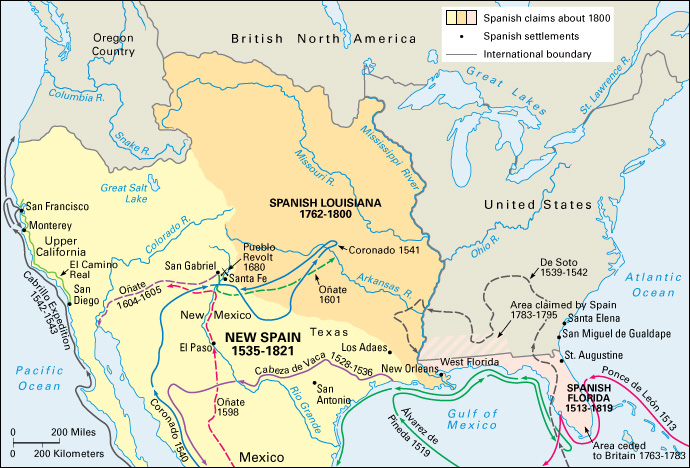New Spain was territory in North America and Central America that Spain controlled from the early 1500’s through the early 1800’s. The heart of New Spain was the area that had made up the Aztec Empire, based in what is now central Mexico, in the 1400’s and early 1500’s.

The Spanish conquistador (conqueror) Hernán Cortés used the name New Spain to describe the Aztec territory he conquered in 1521. In 1522, the Spanish monarchy granted Cortés administrative, judicial, and military control of New Spain. Cortés soon rebuilt the Aztec capital of Tenochtitlan << tay nohch TEE tlahn >> and renamed it Mexico City. He made it his colonial capital. Cortés gave his followers encomiendas—that is, grants of labor and payments from the indigenous (native) population. He also launched campaigns to expand his rule. Cortés sought lands south and east into Central America and the Yucatán Peninsula; west to the Pacific; and northwest to the Baja California Peninsula.
Over time, a number of problems caused the Spanish government to become concerned about Cortés’s leadership. Although many of Cortés’s expansion campaigns were successful, indigenous peoples to the north and in the Yucatán Peninsula resisted Spanish control. In addition, some campaigns took Cortés away from Mexico City at a time when the capital needed strong leadership. The encomienda system also led to abuses of indigenous people.
In the 1520’s and 1530’s, the Spanish government sent various officials to New Spain. Spain aimed to build a bureaucracy (system of government by officials) to replace Cortés’s authority. The officials included treasury officers sent to oversee royal finances in Mexico City, a magistrate (judge) sent to investigate Cortés’s governorship, and a royal high court called the audiencia.
In 1535, New Spain became a viceroyalty—that is, an area managed by a representative of the monarch. The founding of the viceroyalty marked the end of Cortés’s power. Antonio de Mendoza became viceroy (the king’s representative) of New Spain. He served as chief executive, financial, and military officer of the colony. From 1535 to 1821, a series of viceroys oversaw the local government and economic matters of New Spain.
The Viceroyalty of New Spain expanded gradually from the former Aztec territory. It came to include Yucatán; most of Central America; lands west to the Pacific, including present-day California and the Baja California Peninsula; northern Mexico; some Caribbean islands; lands in what are now the southwest and southeast United States; and the Philippines. Spain even claimed territory as far north as present-day Canada.
Boundaries in the northern part of New Spain changed frequently. The Spanish faced resistance from indigenous peoples, as well as challenges from rival imperial powers, mainly France and the United Kingdom. In 1821, New Spain became the independent country of Mexico.
